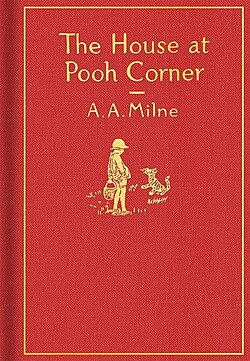Background
Between the release of the 1926 Winnie-the-Pooh and this novel, Milne and Shepard released Now We Are Six . The release comprised a collection of poems, including some that featured the Pooh characters. While writing this novel, Milne decided that he wanted to end the series as Christopher Robin Milne was getting older. [5]
The House at Pooh Corner entered the public domain in the United States in 2024. [6] British copyright of the text expires on 1 January 2027 (70 calendar years after Milne's death) while British copyright of the illustrations expires on 1 January 2047 (70 calendar years after Shepard's death).
Adaptations
Musical recordings
In 1968 Jefferson Airplane referenced the book in their song "The House at Pooneil Corners", a surrealistic depiction of global nuclear war co-written by Paul Kantner and Marty Balin, ending with the line "Which is why a Pooh is poohing in the sun." [11]
In 1970, singer-songwriter Kenny Loggins penned a song using the book's name for the Nitty Gritty Dirt Band on their album Uncle Charlie & His Dog Teddy . [12] In 1971, Loggins would record the song with Jim Messina as part of Loggins and Messina for their 1971 album, Sittin' In . Loggins wrote the song when he was seventeen when reflecting upon his high school graduation. [12] The song is told from the perspective of both Winnie-the-Pooh and Christopher Robin. The song uses verses and allusions to the book as allegorical musings on the loss of innocence and childhood and the nostalgia for simpler, happier times. The first verse, told from Pooh's point of view, describes how he and Christopher's days together "disappeared all too soon" and how he "hates to find [his] way back to the Wood." [13]
In 1994, Loggins re-released the song as "Return to Pooh Corner" on the album of the same name. This version featured a new verse reflecting upon Loggins' own experiences as a father. [12] The added third verse is told from the perspective of an adult Christopher Robin who gives Winnie-the-Pooh to his own son and hears Pooh whisper to him, "welcome home." [14] The song features backing vocals from Amy Grant. [14] Loggins would later invoke the book's title again in 2000 with More Songs from Pooh Corner .
Audio recordings
In 1960, a recording was released by His Master's Voice, a dramatised version with songs (music by Harold Fraser-Simson) of two chapters from the book (2 and 8), starring Ian Carmichael as Pooh, Denise Bryer as Christopher Robin, Hugh Lloyd as Tigger, Penny Morrell as Piglet, Terry Norris as Eeyore, Rosemary Adam as Kanga, Tom Chatto as Rabbit, and Rex Garner as Owl. This was released on a 45rpm EP. [15]
In 1988, an audio version of the book, published by BBC Enterprises, was narrated by Alan Bennett. [16]
In 1997 Hodder Children's Audio released a dramatisation of the book with Stephen Fry as Pooh, Sandi Toksvig as Tigger, Jane Horrocks as Piglet, Geoffrey Palmer as Eeyore, Judi Dench as Kanga, Finty Williams as Roo, Robert Daws as Rabbit, Michael Williams as Owl, Steven Webb as Christopher Robin, and narrated by Judi Dench and Michael Williams. The music was composed and played by John Gould, and directed by David Benedictus. [17]
This page is based on this
Wikipedia article Text is available under the
CC BY-SA 4.0 license; additional terms may apply.
Images, videos and audio are available under their respective licenses.
